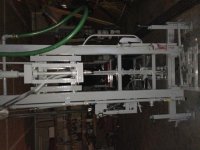Report on fix?
I installed a needle valve at the large diameter end of the ram and a low pressure cartridge in the spool valve.
Result:
Adjusted for 1400 psi and a very slow fill the mast is easily controlled and at low mid rpm the engine/ pump system works hard but does not stall.
A propotional valve would have worked but at a higher cost and more mounting and hoses.
It is ready for a trial run?...??? Still 10 degrees and two feet of snow so it will be a couple of months.
When I do, I will take pics and report even if there are troubles . Promise
. Promise
One more note on it:
I made my own water swivel and tested it with 100 psi air with no problems. The real test will be pumping well mud through it for hours on end.
Thanks to everyone for your input and all else.
Gray
I installed a needle valve at the large diameter end of the ram and a low pressure cartridge in the spool valve.
Result:
Adjusted for 1400 psi and a very slow fill the mast is easily controlled and at low mid rpm the engine/ pump system works hard but does not stall.
A propotional valve would have worked but at a higher cost and more mounting and hoses.
It is ready for a trial run?...??? Still 10 degrees and two feet of snow so it will be a couple of months.
When I do, I will take pics and report even if there are troubles
One more note on it:
I made my own water swivel and tested it with 100 psi air with no problems. The real test will be pumping well mud through it for hours on end.
Thanks to everyone for your input and all else.
Gray



